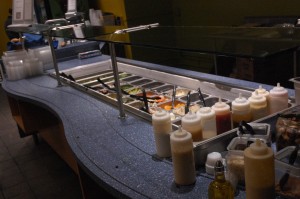Trouble at the Salad Bar
Good News For Light Salads – Bad New for Big Salads
September 23, 2014
A wave of controversy has surrounded the salad bar in the NEIU cafeteria—the flat prices are gone, and in their stead is a new weight system; 39 cents per ounce of ingredients. The new system has been both praised and disparaged. Some students and faculty have managed to buy salads as low as $3.19, but others found themselves paying upwards of $9.00.
The original salad prices were flat: $3.59 for a small and $4.95 for a large. It was a better value to buy a large salad. This has flipped—small salads are more affordable now than ever before, while large, heavy salads prove a financial burden.

Some are pleased with the ounce system: “Their salad bar is (expletive) money!” said Luke McCarthy, a NEIU student. He sang praises of the quality and variety of ingredients and condiments the new salad bar offered, but warned not to buy the pre-made salads that lurk in the refrigerator.
Another student, Jason Merrill, said, “I think if you’re adding a lot of heavier items like meat and salad dressing and whatnot, and just overloading it with items it totally could reach $9, but for a sensible one-serving salad it’s going to be about four-ish, five-ish dollars.” He added, “I will say they need to label the dressing. Unless there’s someone standing nearby I have no idea what they are.”
But many big-salad eaters feel cheated: “It cost $16 and some cents,” said student Michael Banozzo, who was in the process of eating a large salad. When asked if he thought the old salad bar was a better deal he said, “It’s the same ingredients; it’s just that this way, it probably costs more because they had a flat fee before.”
“I just think the price needs to come down a little bit per ounce…I think it’s a little high. Although I will make two meals out of this,” added Banozzo.
When asked about the new salad pricing Mark Weiner, Food Service Director for A’viands at NEIU said, “They are [more affordable] because people are making the salads they want to make…on average these are coming in lower.”
There are, however, other concerns for A’viands, who currently struggle to maintain affordable pricing and healthy ingredients in a market where the cost of raw products is rapidly increasing.
“We’re struggling with price increases all the time and we’re doing our best to make sure those aren’t transferred to our customers…we haven’t changed any signs this year even though the raw prices have gone up,” Weiner said.
The new format has also faced criticism for its open bar, buffet policy. Detractors fear it might be unsanitary, and that’s not a completely unfounded concern. NEIU is attended by students who ride the CTA daily, and jaded longtime riders know of the filthy goings-on of the busses and trains of Chicago.
I have always been of the opinion there’s nothing worth eating that can’t kill you, it just doesn’t seem fair. But when it comes to affordability, any salad running $16.00 is deeply unsettling.
There’s nothing else in the cafeteria that comes close to that kind of price, and many—much cheaper—alternatives are near the same weight. Most students lack the nest of capital required to invest in any $16.00 meal, let alone something made simply to sustain us between classes.
It was no mystery that the old salad bar needed some kind of change—it was a bleak place that often left students feeling vaguely paranoid or depressed. That was one of the contributing factors for my switch to sandwiches. Often, there was only one server there and it often felt lonely and vacant.
Salads are a big deal these days; healthy living is “in”, with the salad at the heart of the movement. They are one of the few meals that can promise every food group. The cost has become more than fair for those who enjoy small salads, great for a side dish, brief refresher, or a light lunch, but for students who rely upon a single, big salad a day, the price becomes heavy and unfeasible very quickly.
It’s simply not affordable for the big-salad eater to buy a heavy A’viands salad with the current deal, and I think this could be curtailed by enforcing a price cap on weight. After a certain weight, the price would no longer increase, though this might also need a maximum on weight allowed, or perhaps a smaller box. Most people assume eating healthy to be an expensive lifestyle, and for NEIU students, that assumption rings true.






